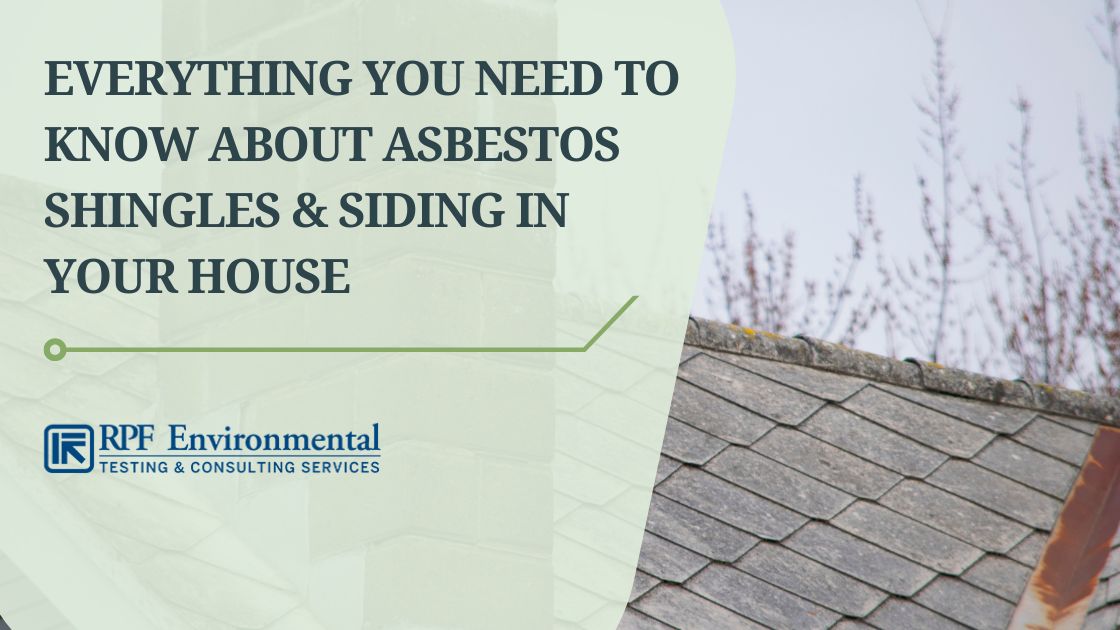You don’t need to worry about asbestos shingles and other asbestos-containing materials (ACMs) in your home if they are in good condition. This is because they are less likely to release toxic airborne fibers. But, remodeling or renovating your home which involves disturbing ACMs, including roofing and siding shingles with asbestos, will put you and your family at risk of exposure.
Keep on reading to know more about identifying and removing asbestos shingles from your home including regulations that you need to follow to avoid fines and penalties.

We are composed of certified and experienced asbestos professionals who offer affordable asbestos testing in Illinois, Indiana, Maine, New Hampshire, Massachusetts, and across the United States. Contact us now for more information!
What Are Asbestos Shingles Siding and Roofing?
These are roofing and siding tiles or sheets that were manufactured with asbestos – a natural mineral consisting of flexible fibers that enhance the materials’ durability. Thus, making them more heat, weather, and corrosion-resistant compared to traditional materials. They are also lightweight and economical alternatives which made them popular during the 1930s up to the 1970s before their use was regulated.
There are two known asbestos-based roofing materials, asbestos-cement shingles and asbestos asphalt shingles, which were both used as roofing and siding materials in homes.
What Should You Do If You Have Asbestos Shingles in Your Home?
If the asbestos materials are in good condition, leave them alone. Do not try to disturb them in any way as this might create a health hazard where none existed before. Leave asbestos testing and removal to the professionals.
Health Risks of Asbestos Siding/Roofing in Houses: Are They Dangerous?
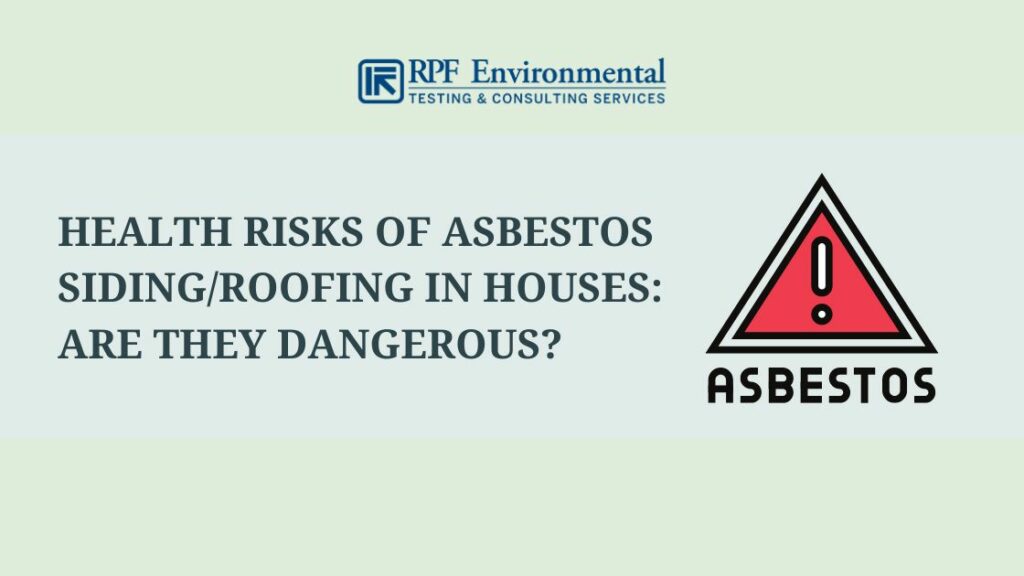
The negative health impacts of asbestos during production were already evident during the 1920s after factory workers suffered from chronic lung inflammation. However, asbestos companies covered up the health risks of asbestos as the business grew into a multibillion-dollar industry. Many workers suffered from respiratory diseases and even those nearby asbestos factories were at risk.
When Does Asbestos Roofing or Siding Become Dangerous?
- Old asbestos roofing and siding shingles become brittle as they age which will cause the release of toxic microscopic fibers into the air once disturbed.
- Weathering, water, heat, and other factors can also cause the materials to become friable (can be crumbled or pulverized by hand pressure).
- Flooding, water damage, fire, and other natural disasters can turn a nonfriable asbestos material friable.
- Any activity that will cause the disturbance of the material during renovation, demolition, and remodeling activities will cause asbestos fibers to become airborne. These activities include sanding, drilling, cutting, sawing, and others.
- Improper removal of asbestos shingles by an untrained individual can also cause disastrous results.
Occupants of the house and even nearby individuals can inhale the airborne fibers. Once the fibers enter your body, they will be trapped inside permanently and can lead to irreversible damage to the lungs among other diseases:
Diseases Caused by Asbestos Shingles and Other ACMs
- Asbestosis (an incurable chronic lung disease caused by prolonged exposure to asbestos fibers)
- Mesothelioma (another incurable and aggressive type of lung cancer that is linked to asbestos exposure)
- Lung cancer and other lung diseases
- Other cancers like ovarian cancer, laryngeal, and kidney cancer
NOTE: You can’t see or smell asbestos fibers so you might be unaware that you are already breathing them in. Also, airborne fibers can stay in the air for days before they settle. However, the fibers are very light and can easily become airborne again even by small movements.
Asbestos House Shingles Identification: How to Tell if You Have Asbestos Shingles in Your Roofing or Siding
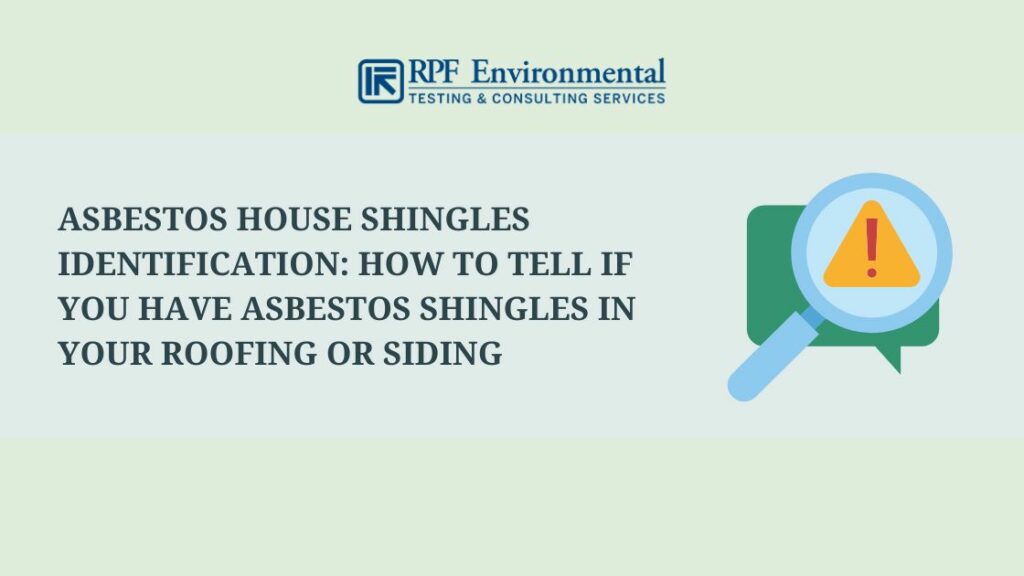
You can’t identify asbestos shingles by mere visual inspection, only laboratory testing of a sample can confirm its presence in your home. However, there are various ways that can help you determine whether your roofing or siding might contain asbestos or not.
NOTE: You should always assume that suspected asbestos materials are dangerous and treat them accordingly. Also, we don’t recommend testing them yourself to avoid increasing your risk of exposure.
What Do Asbestos Shingles Look Like?
- Asbestos-Cement Roofing Shingles – Usually resemble slate or shakes but slate-style shingles are the most popular types
- Asbestos-Cement Siding Shingles – Look like machine-grooved shingles or shakes with painted finishes and most are thinner compared to asbestos-cement roofing shingles
- Asbestos-Asphalt Shingles – Look similar to asbestos-cement shingles but are made of asphalt-impregnated fiberboard and can come in various colors in different shades (e.g. red, gray, green, etc.)
In addition, asbestos shingles often came in shades of gray in square, rectangular, or diamond shapes. You can learn more about asbestos-cement shingles identification in InspectAPedia’s article.
Other Ways to Determine if Your House Has Asbestos Roofing or Siding Shingles
Method 1. Look for Markings
Asbestos markings are among the definite signs of having asbestos siding/roofing in your house. Look for markings on the material and in the packaging if you still have it. You can call the manufacturer if possible.
Below are some of the known manufacturers of asbestos-containing roofing and siding materials to guide you:
Manufacturers of Asbestos-Containing Roofing & Siding Products
- Keasby & Mattison
- United States Gypsum
- Rutland Fire Clay
- Rhone-Poulenc AG
- Atlantic Asphalt & Asbestos
- Monroe
- National Gypsum
- Johns-Manville Corporation
- GAF/Ruberoid
- Kaylite
- Flintkote Company
- General Aniline and Film Corporation
- Fibreboard Corporation
- Celotex
- Bird and Son
- Carey Manufacturing
- Barrett Roofing Company
- Barber Asphalt Corporation
- G.W. Berkheimer Company, Inc.
Method 2. Determine Your House’s Age
Determining when the shingles were installed or when the house was built is another method of spotting asbestos-contaminated materials in your home. If your house was built between the 1920s and the 1980s, there is a high chance that you have asbestos shingles.
Also, some asbestos roofing/siding products (e.g. mastics, coatings, etc.) are often not labeled as containing asbestos. Therefore, knowing their installation date is enough to determine if they might contain asbestos or not.
Signs of wear and tear also imply that the materials are old and might already be releasing toxic asbestos fibers.
Also Read: Asbestos in the Home: How to Know if an Old House Has Asbestos
Method 3. Determine the Type of Shingles
As we’ve mentioned, asbestos is common in cement and asphalt shingles. They can also come in other forms like corrugated cement roofing and cement roof tiles which also contained asbestos. Aside from the shingles themselves, take note that asbestos may also be present in the following products:
Roofing & Siding Products That May Contain Asbestos
- Built-up roofing
- Roof underlayment felts or tar paper
- “Slate” siding
- Wood shake vapor barriers
- Roll roofing
- Transite siding
- Sealants
- Base flashings
- Mastics
- Coatings
- Paint
Method 4. Hire a Certified Asbestos Inspector
The most effective method in identifying asbestos materials in your home is to hire a professional asbestos inspector like RPF Environmental. Licensed asbestos experts will collect samples and perform laboratory analysis for accurate results.
Also Read: Asbestos Inspection & Survey Reports: What to Expect During Asbestos Inspection
Asbestos in Roofing and Siding Removal, Encapsulation, and Replacement
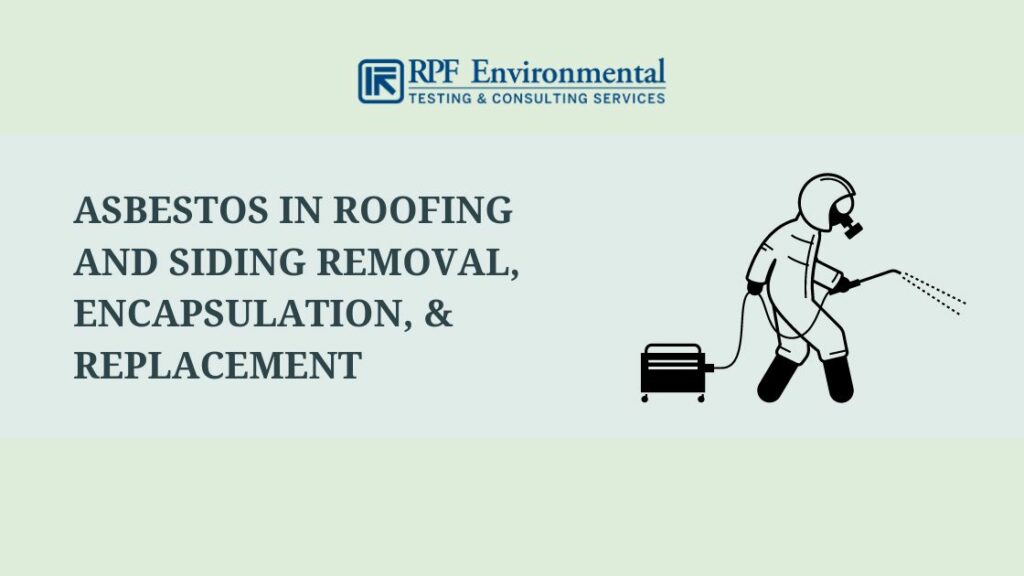
If you want to ensure your family’s safety and want to minimize the risks of asbestos exposure in your home, you can opt for repair or removal.
NOTE: Don’t repair or remove asbestos shingles yourself. Disturbing the materials will cause asbestos fibers to become airborne and can get into your lungs which increases your risk of developing asbestos diseases. Let licensed professionals handle them. Plus, you need to follow proper asbestos removal regulations to avoid penalties.
Asbestos Shingles Repair: Encapsulation and Enclosure
Asbestos shingles that are in good condition can be repaired through encapsulation (sealing) or enclosure (covering). This is usually a cheaper option than removal. In addition, since encapsulation and enclosure only require minimal disturbance, they help minimize asbestos risks.
However, you should only do repair if removal is not necessary because you might end up spending more later instead of saving money.
Method 1. Asbestos Roofing & Siding Encapsulation (Sealing)
Sealing or encapsulating asbestos materials involves applying a protective layer (a sealant or encapsulant coating) over the surface of the material to bind the fibers together. This provides the material additional protection from damage which prevents the fibers from becoming airborne.
Asbestos Shingles Painting
If you prefer painting your asbestos roofing or siding shingles, start with a good primer to seal cracks and prevent peeling. Then, use an encapsulant paint or a high-quality acrylic latex paint for longevity.
Method 2. Asbestos Roofing & Siding Enclosure (Covering)
Enclosure means placing something over the asbestos material to prevent the release of toxic fibers.
Siding Over Asbestos Shingles
Putting new siding (vinyl) over asbestos siding shingles has been a common practice. Encapsulating the existing asbestos shingles is often the first step before covering them to avoid flaking and creating health hazards. This is followed by adding a plastic sheeting or vapor barrier and then a foam or insulation board before installing the new siding. However, you need to verify if your local codes allow you to do this.
Asbestos Roofing and Siding Removal
Professional asbestos removal is done when:
- You’re renovating or remodeling your home which will require making major changes that will disturb the asbestos materials
- The asbestos shingles are extensively damaged and repair is not possible
Asbestos removal is a complex and dangerous process that should only be done by trained and licensed asbestos professionals. Since there is a very high risk of releasing asbestos fibers, the bulk of the cost will be for reducing the risks which makes removal expensive.
Asbestos Shingles Replacement: How to Replace Asbestos Shingles
The process of replacing asbestos shingles is the same as that of regular roofing or siding replacement with additional requirements and steps:
- It is done by a trained professional
- The crew needs to wear the right protective gear
- The work area is sealed off and warning signs are posted
- Safety protocols should be followed
- Extra care should be taken to minimize damage to the shingles during the removal process
- The removed asbestos shingles should be disposed of properly at a certified asbestos disposal facility
Safety Tips for Handling Asbestos Shingles in Your Home
- Repairs, regardless of whether they are minor or major, should only be done by professionals (asbestos abatement firms).
- If you insist on doing minor repairs, make sure that you are properly trained to handle asbestos first and make sure local laws allow you to. You can check for asbestos training programs in your area.
- Better hire a contractor that is experienced in handling asbestos materials if you will be doing renovation works.
- Do not vacuum, sweep, or dust asbestos debris to avoid disturbing the fibers. Professionals use special HEPA vacuums when cleaning up asbestos waste.
Who Should You Hire for Asbestos Shingles and Siding Removal/Repair?
Hire a certified asbestos contractor or abatement company to ensure your family’s safety. They have the needed equipment and have undergone rigorous training so they can handle asbestos-containing materials safely and properly. They are also well-versed in asbestos regulations which will save you from costly violations.
Tips on Working With an Asbestos Abatement Contractor
- Be aware of contractors or consultants that are encouraging unnecessary asbestos removals. Removal should be your last option.
- Always ask for a written contract before the removal starts. The contract should specify the cleanup and work plan along with regulations that should be followed.
- Aside from state and federal regulations, make sure that your contractor follows asbestos removal and disposal laws in your area.
- Make sure that the contractor uses proper equipment, especially protective clothing.
- Ask how the contractor will prevent asbestos dust from spreading like sealing off the work area, turning off the HVAC system, covering air vents, etc.
- Ask about the removal and cleaning process after completion to ensure that exposure risks are minimized.
How Much Does Asbestos Shingles Removal Cost?
Asbestos roofing removal is one of the most expensive asbestos removal projects due to the difficulty and danger involved in the process. It usually ranges from $50 to $120 per square foot excluding disposal fees.
For asbestos siding removal costs, the average cost ranges from $10,500 to $13,500 with a 1,500-square-foot shingle siding costing around $12,000. You can read a more detailed discussion about asbestos costs here.
Asbestos Shingles Disposal
For asbestos siding/roofing disposal, asbestos wastes must be disposed of properly by:
- Wetting them first before double bagging them in plastic bags
- Packaging them in leak-tight containers to prevent the release of asbestos fibers during transit
- Labeling them properly
- Disposing of asbestos waste at licensed disposal sites
Always check if the facility accepts special waste like asbestos because dumping asbestos in regular landfills can cause liability issues.
Regulations for Asbestos Shingles Removal & Disposal
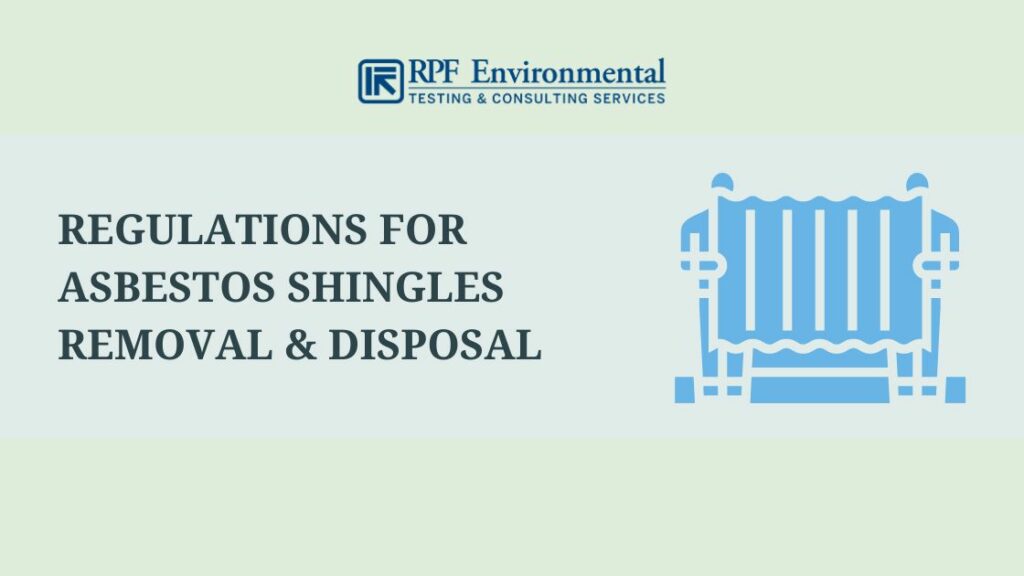
There are various laws and regulations that govern asbestos removal and disposal including EPA and OSHA’s regulations. EPA has the National Emission Standards for Hazardous Air Pollutants (NESHAP) that specify work practices for building renovations and demolitions and other laws that apply to schools. OSHA’s asbestos rules focused on handling asbestos in the workplace to manage occupational safety.
Although these regulations don’t apply to private homes, asbestos professionals who perform the removal and disposal should still follow state and/or federal regulations. Also, laws may vary depending on where you are. But in most cases, a licensed professional is always required for handling asbestos and DIY removal or repair is prohibited.
So before you remove asbestos yourself or perform other asbestos-related work, especially disposal, make sure that you check local guidelines and laws to avoid penalties. Asbestos-related works include enclosure and encapsulation of asbestos aside from removal.
Moreover, permits need to be acquired before doing any work involving asbestos. Involved authorities must also be notified especially when the amount of asbestos to be removed exceeds a certain amount.
Other Things You Might Want to Know About Asbestos in Siding and Roofing
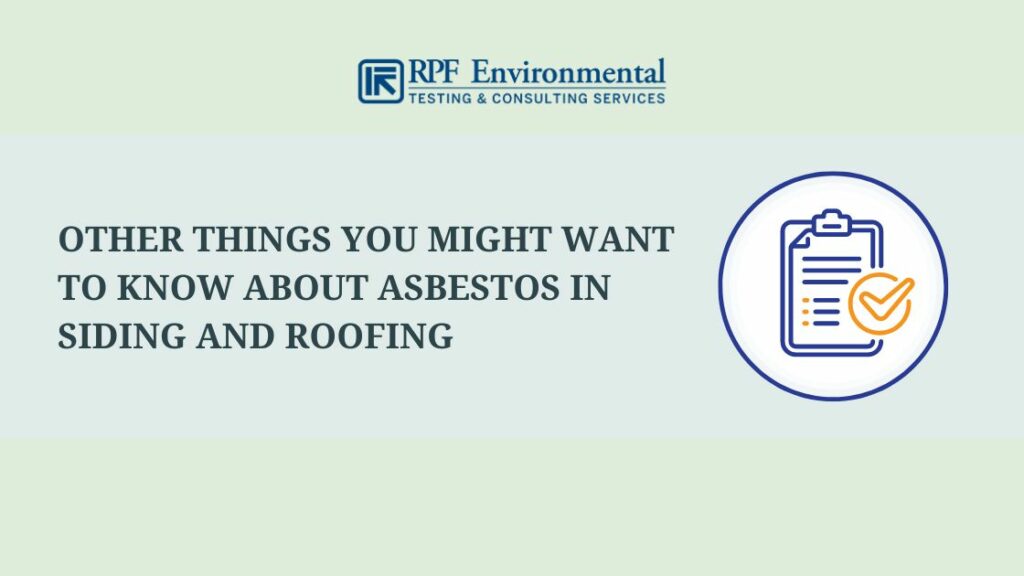
When Were Asbestos Shingles Used?
Asbestos was popularly used in roofing and siding shingles from the 1920s up to the early 1980s due to its fire resistance, durability, and insulation properties. Unlike traditional wood, slate, and clay roofing materials, asbestos shingles were more weather-resistant, won’t rot or warp, and are resistant to insect damage.
When Were Asbestos Shingles Banned?
Though asbestos is not yet completely banned in the U.S., EPA and OSHA took actions to protect the public from exposure. Regulations became stricter in the 1970s and the popularity of asbestos declined. In 1989, EPA issued a rule banning most ACMs and in April 2019, EPA issued a final rule that prevents discontinued asbestos products from returning to the market. These products include asbestos-cement shingles, roofing felts, roof coatings, mastics, and others.
Also Read: Have New Asbestos Products Really Been Eliminated?
Are Asbestos Shingles Still Used?
The use of asbestos-containing products declined rapidly starting in the 1970s and new uses of asbestos, including asbestos shingles, have been banned. So, new roofing or siding shingles made after 1989 are safe from asbestos.
Do You Need to Remove Asbestos Shingles in Your Roofing or Siding?
No. Asbestos siding/roofing that is still in good condition should be left alone. Repair or removal should only be done by a professional if the materials are damaged and repair can’t be done.
Can You Remove Asbestos Shingles Yourself?
Although no laws are prohibiting you from removing asbestos from your home, there are laws for asbestos disposal that you need to follow. However, it depends on your local asbestos laws whether you’re allowed to perform any asbestos-related work yourself or not. Professional removal is most often necessary to ensure safety and minimize risks.
Also Read:
- How to Identify Sheetrock Asbestos: What Does Asbestos Drywall Look Like?
- Asbestos Insulation Identification: What Does Asbestos Insulation Look Like?
- How to Identify Asbestos Floor Tiles: What Does Asbestos in Flooring Look Like?
- How to Identify Asbestos Plaster Walls: What Does Asbestos Look Like in Walls?
FAQs
Visual inspection is not possible to identify asbestos shingles in your home. But, there are a few methods to determine the possibility of your roofing or siding shingles having asbestos:
1. They are asphalt or cement-based shingles
2. The shingles are installed from the 1920s to the 1970s
3. Determining the manufacturer of the materials
4. Looking for “asbestos-containing” markings
5. Hiring a professional asbestos inspector
Asbestos shingles were common from the 1920s to the early 1980s before they were banned in 1989.
Asbestos shingles were designed to be long-lasting and can last for an average of 30-50 years. However, old shingles may become brittle and release toxic fibers which will require professional removal.
Conclusion
Professional testing for asbestos on roof and siding tiles is the only way you can determine their presence in your home. But, houses built from the 1920s to the early 1980s have a high chance of containing asbestos shingles and other asbestos materials. Removal should only be done by a professional if repair is not possible.
If you are worried about asbestos shingles in your home, RPF Environmental’s professionals can help you test for asbestos at prices you can afford. We serve areas in the New England regions and across the United States including Maine, Massachusetts, and New Hampshire. Contact us now!

